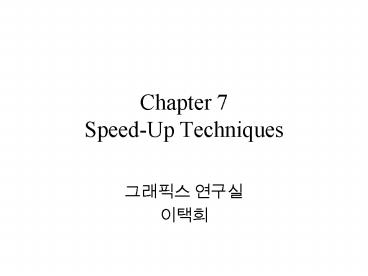Chapter 7 SpeedUp Techniques - PowerPoint PPT Presentation
1 / 24
Title:
Chapter 7 SpeedUp Techniques
Description:
Shadow Culling. Hierarchical Z-Buffering and the Hierarchical Visibility Algorithm ... Shadow Culling. Impostors(Sprite) Nailboards. Hierarchical Image Caching ... – PowerPoint PPT presentation
Number of Views:32
Avg rating:3.0/5.0
Title: Chapter 7 SpeedUp Techniques
1
Chapter 7Speed-Up Techniques
- ???? ???
- ???
2
Culling Techniques
- Backface and Clustered Culling
- Hierarchical View-Frustum Culling
- Portal Culling
- Detail Culling
- Occlusion Culling
- Shadow Culling
3
Backface and Clustered Culling
Cross product
Dot product
4
Hierarchical View-Frustum Culling
BV(Boundary Volume) Tree
5
Hierarchical View-Frustum Culling
VB Tree
6
Hierarchical View-Frustum Culling
Axis Aligned BSP Tree
Polygon-Aligned BSP Tree
7
Portal Culling
Densely occluded architectural scene, this
algorithm was able to cull about 99 of the
geometry with a speed-up of over 100 times.
8
Detail Culling
- Sacrifices quality for speed.
9
Occlusion Culling
Pseudo code for a general occlusion culling
algorithm
10
Occlusion Culling
- Hierarchical Z-Buffering and the Hierarchical
Visibility Algorithm - The HOM(Hierarchical Ocllusion map) algorithm
- Hierarchical Polygon Tilling
- Shadow Culling
11
Hierarchical Z-Buffering and the Hierarchical
Visibility Algorithm
The construction of quadtree(octree)
Hierarchical Z-buffer
12
Hierarchical Z-Buffering and the Hierarchical
Visibility Algorithm
13
Hierarchical Polygon Tilling
- Only traverses regions of the screen where a
polygon is visible or nearly visible.
14
The HOM(Hierarchical Ocllusion map) algorithm
Occlusion map(overlap test)
15
The HOM(Hierarchical Ocllusion map) algorithm
Z-depth test
16
Shadow Culling
17
Impostors(Sprite)
- Nailboards
- Hierarchical Image Caching
An impostor needs to be regenerated every time
Beta(tex), Beta(trans), Beta(size) is greater
than Beta(scr).
18
Nailboards
- The nailboard texture image is an RGB image
augmented with a parameter for each
pixel, thus forming RGB Texture. - The stores the depth deviation from the
nailboard polygon to the correct depth of the
geometry that the nailboard represents
19
Level of Detail
- Discrete Geometry LODs
- Alpha LODs
- Geomorph LODs
- LOD management
20
Discrete Geometry LODs
21
Triangle Strips, Fans, and Meshes
- Strips
- Fans
- Creating Strips
- Polygon Meshes
22
Strips
23
Fans
24
Creating Strips
- The SGI algorithm - Greedy algorithm
- The STRIPE algorithm
doubling
patchification































